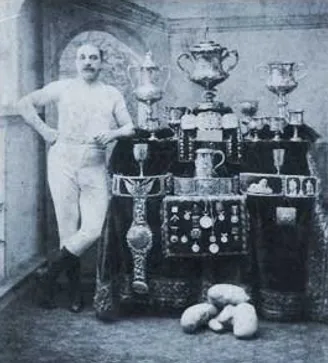Updated: Sep 4, 2023

November, 2020
When I was a young mother living in Norwich, I used to push my babies out in their pram along Dereham Road and was always intrigued by a large stone memorial dedicated to boxer Jem Mace which stood outside the premises of a monumental mason. The name stuck in the back of my mind and now I have learned his amazing history which began in 1831 at Beeston-next-Mileham, a tiny isolated village in the wilds of Norfolk.
From a poor working-class background, young Mace inherited his father's ability to play the fiddle which gave him the opportunity to earn coins playing pubs and fairs. A brawl with three fishermen outside a public house in Great Yarmouth however, saw the end to that with his precious instrument smashed. Enraged, Mace knocked out two of the thugs while the third fled. Impressed by the show of strength from the slight lad, a gent gave Mace a guinea along with the suggestion that he become a prize-fighter.
The 1850s saw the emergent James "Jem" Mace in London where he became an exhibition boxer, fencer and wrestler associated with Nat Langham, a well-known retired prize fighter who ran a booth. This was solid training for Jem as he moved around the country. A good fight with a touch of showmanship meant money in the hat passed around the crowd afterwards! In London he made extra by giving sparring and training sessions at Langham’s Cambrian Stores boxing club.

In September 1858, Mace met Bob Brettle under London Prize Rules in what is now considered to have been the Welterweight Championships of England for £100 a side. (Bearing in mind the average labourer's earnings were £40 per year if he was lucky, this was a good purse!) Though he conceded after only two rounds, in a second attempt he took the title.
Billed theatrically (and incorrectly), first as The Swaffham Gypsy and then The Gypsy, Mace worked his way up to the top of the prize-fighting scene and in 1861, he became Heavyweight Champion of England by beating reigning champion Sam Hurst, 50 pounds heavier and three inches taller, in an eight-round brutal fight at Medway Island, Kent in which he all but killed his opponent before the police arrived. Mace won his first defence of the title against Tom King in 1862, for £200 a side with a rematch in November the same year for the same purse, but a slip to the grass caused his seconds to concede the match.
Salve no doubt to Mace’s bruised ego, came in February 1863 when he received The Windham Cup, a chased gold trophy in recognition for his win and considered to be worth about £100,000 in today’s money! In September of that year, for a split purse of £1,000 Mace fought for and won the English Middleweight title against Joe Goss, using the technique he had perfected.
Over 20 rounds, on 6th August, 1866, Jem regained his title of English Heavyweight Champion, splitting the exceptional £1,000 prize money with his opponent, again Joe Goss, after both men added weight to their bulk.
Successful pugilists found the type of fame and fortune we are familiar with today in what was considered at the time to be the national sport. Such was Mace’s popularity that he drew a crowd of 10,000 to greet him at Liverpool’s Lime Street Station and was carried on their shoulders through the streets on a return visit to the city after the match. Clearly his respect and popularity as boxing instructor and judge following the Liverpool Olympics in the 1860s ensured good crowds wherever he performed.

Despite a veneer of respectability, clandestine matches with an undefined number of rounds and attendant crowds of gamblers and ruffians were arranged to be fought usually outdoors in remote locations and all weathers, and as such were subject to raids by police. Having suffered arrest in 1867 the night before a scheduled title defence and held over in court not to fight again for two years, Mace left England to further his career in America where in May 1870 in Kenner, Louisiana, he defeated English-born American Tom Allen for a massive purse of £2,500 a side. The fight is now considered by boxing historians to have been the first World Heavyweight Championship and a celebrated Mace would go on to give exhibition fights in New Jersey and New York.
Frequent visits to America followed, and in 1878-9, after an attempt on his life, he travelled to Australia to perform around 30 exhibitions under Queensbury Rules which he had a hand in drafting and which required, amongst new rulings, the wearing of gloves.

1882 saw Mace in New Zealand where he schooled new boxers and discovered future champions. The following years saw him criss-crossing the globe performing exhibitions in the world of sport showmanship that had begun so early in his career.

Used to the lure of the nomadic fairground circuit and though officially retired from boxing, he toured Lancashire putting on exhibitions with various travelling shows including that of Norwich’s Pablo Fanque (William Darby), the first black man to own and run a circus. Later he put on entertainments across the country in a circus of his own. He also became the proprietor of The Strawberry Gardens pleasure grounds in West Derby, Lancashire featuring running, bowling, wrestling and boxing. Various licenced premises and hotels (including the White Swan Inn in Norwich) and others in America and Australia passed through his hands as the rich and ambitious wanderlust travelled the world and kept company with Royalty, toffs, gamblers and showgirls.

Approaching age 59 in 1890, the draw of the ring proved too much and Mace fought unsuccessfully for the English Heavyweight title losing in four rounds. Never daunted, he continued exhibition fighting, even opening a boxing academy in faraway Cape Town where he performed himself in 1903 and 1904. Throughout all this time, Jem never forgot his musical inheritance and continued to play the violin.
Astonishingly, Mace's last fight was at age 78, shortly before his death in 1910, when he was still travelling the fairground circuit and performing in music-halls as lecturer to Billy LeNeve’s troupe of lady athletes and gentleman boxers. His appearances were sell-out successes: ‘...all they wanted was to see and hear the unconquered champion of the world. Their sole ambition was to gaze upon the veteran of the pugilistic ring, so that every day, and at every performance throughout the week, the standing order at this world-famed establishment was either standing room only or house full.'

It is little surprise to find Jem Mace had no fixed abode in old age since fighter, racehorse owner and sometime dandy, he had made and gambled away a fortune. Married four times (twice bigamously), he had at least 14 children by five women.
In today’s currency, it is estimated that in his prime he made the equivalent of £200,000,000 but for all that, in 1910, at the age of 79, itinerant Jem had returned to playing fiddle at fairs and pubs. Despite his sell-out reputation, he died penniless in Jarrow, Durham. His only possessions were his cherished violin and bust of Tom Sayer, his greatest rival, which he had refused to sell. World-renowned pugilist, Jem Mace was to suffer an ignominious end, finally being buried in an unmarked pauper’s grave.
In much-belated recognition of his hard-won and largely forgotten achievements, in 2002 Merseyside Former Boxers arranged a memorial headstone for his grave and the city of Norwich has a blue plaque in Swan Lane, in recognition of his success. He has also since been inducted into the International Boxing Hall of Fame as well as the Australian National Boxing hall of Fame.
Though Mace dictated the story of his life 'Fifty Years a Fighter', published in 1908, he remains pretty-well unknown in his native land where he surely deserves recognition for boxing his way out of illiterate poverty to international stardom in his field, and whose boxing career is longer than any other in recorded history.

Back in Kenner, a bronze life-sized statue of two fighters marks Jem Mace's greatest achievement as the first Heavyweight Boxing Champion of the World.
In Norfolk there is practically nothing save the weather-worn monument I saw fifty years ago, re-erected to stand in forlorn isolation beside his father’s grave in the backwaters where it all began, Beeston.













